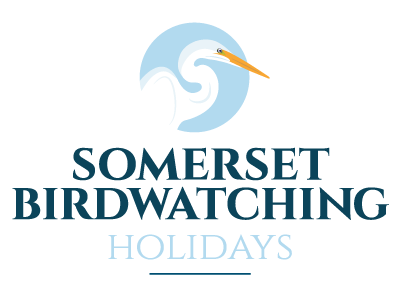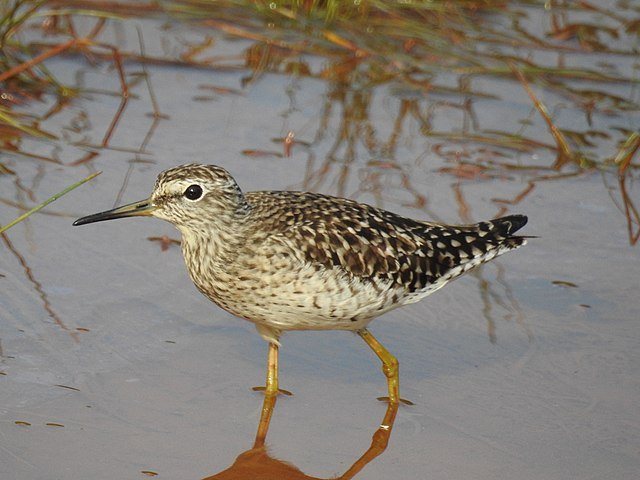The world stood still, then the birds reminded us that the world was still turning.
Monday 19th September
After a sombre morning watching the Queen’s funeral, the idea of some fresh air and a spot of birding was a welcome tonic to all. Prior to leaving Walls Farm a Grey Wagtail had been seen along with a Green Woodpecker on the lawn, a singing Chiffchaff was deep in the hedge alongside the subtle call of a Bullfinch.
The skies were empty, as all local Swallows had departed for southern climes, although as we drove through the village of Mark three or four passage birds were seen going over.
We parked up in Highbridge at the estuary of the River Brue on a falling tide. Immediately we picked up some Common Sandpipers on the muddy riverbank along with a large group of Redshanks (several hundred). Dotted among them were a good sprinkling of Turnstone, still in their smart breeding plumage. Grey Heron and Little Egrets were also on the river’s edge and a small group of Pied Wagtails and Linnets worked the grassy higher ground.
At the mouth of the river where the Brue joins the river Parrett estuary and the sea, we had a clear view over Steart Island to Flat Holm and Steep Holm islands in the middle of the Bristol Channel, with Cardiff and the distant Brecon Beacons beyond. Herring, Black-headed, Great Black-backed and a single Common Gull were seen. Many Shelducks were on a sandbank beyond Steart Island, and some gave a closer flypast going upriver. Curlew were calling and a Kestrel hovered nearby. Meadow Pipits, Goldfinches, a single Oystercatcher and just two Dunlin were also observed; and just as we were about to head back to the van a group of 20+ Avocets flew by in a long thin line, heading upriver.
In the evening we were joined by Stephen, and all enjoyed one of Kay’s excellent Welcome Suppers. At the end of the evening a very vocal Tawny Owl hooted away in a corner of the garden as our guests headed off to bed.
Tuesday 20th September
The morning dawned calm, cool but bright and sunny – definitely ushering in autumn; though it would get quite warm later in the day! Nevertheless, the spring sound of a singing Chiffchaff echoed around Walls Farm garden, as Swallows flew overhead at the start of their long journey south.
We headed down to Tealham Moor, where we came across a very active Great White Egret feeding in a rhyne, and a Cattle Egret overhead. At our regular stop, we managed the trio of migrant chats – Wheatear, Stonechat and a smart young Whinchat – all occupying distant fence posts, from which they hopped down to pick up insects. There were also distant Buzzards and Kestrel, Canada Geese, Skylarks, and lots of Swallows heading purposefully south-east. Halfway along we came across at least 20 Cattle Egrets feeding amongst the cattle, and flocks of Meadow Pipits.
We reached the RSPB Ham Wall reserve where we enjoyed coffee and posh biscuits, followed by brief but excellent views of a male Bearded Tit (or more properly, Reedling) in the reeds just past the tiny visitor centre. On the walk along the disused railway line we came across a tatty male Blackcap, heard a Bullfinch calling and had cracking views of another Great White Egret, which posed very nicely for photos as it fed along the edge of the drain, seemingly unbothered by our presence. More Swallows continued to fly past, and we also saw Little and Great Crested Grebes, 9 Common Snipe overhead, and a lovely view of a male Great Spotted Woodpecker perched beneath a Wood Pigeon on a dead tree.
From the first viewing platform we enjoyed views of a female Marsh Harrier, more Great White Egrets and two distant Stock Doves; further along we had brief views of a late Hobby, as Cetti’s Warblers and Water Rails called noisily in the reeds. The second viewing platform was, as it is at this time of year, more open and so more productive than the first. We enjoyed an excellent comparison between Green and Wood Sandpipers – the latter lighter than the former, with a clearer eyestripe and spangled plumage on its back; along with a few Snipe. There were also Little and Great White Egrets and a second Hobby. On the way back, we saw lots of Common Darter and Emperor dragonflies and a Speckled Wood butterfly.
Wood Sandpiper
After a fine lunch in the garden of The Duck at Burtle, during which Graeme spotted a distant Red Kite with a Buzzard (and Stephen noted a Common Blue butterfly), we drove the short distance to Catcott Lows, a Somerset Wildlife Trust nature reserve. Catcott always produced the goods, and immediately we got great views of 40 Cattle Egrets (later flushed by a Marsh Harrier, which was in turn mobbed by 4 Rooks), along with Great White and Little Egrets; some Canada Geese, some early wintering Wigeon and the usual ducks. Insect-lovers enjoyed the unexpected appearance of a splendid Clouded Yellow butterfly – a scarce migrant from across the Channel – which posed beautifully while feeding on a thistle.
For our final stop we enjoyed a lovely but rather birdless walk around the most outlying reserve on the Avalon marshes, Westhay Moor; apart from a Marsh harrier and brief singing Chiffchaff, there was not a lot to see; though the walk was rather lovely in the warm afternoon sunshine. There was a lone adult Mute Swan with no fewer than eight well-grown cygnets, plus a Little Grebe, several Shovelers, and lots of dragonflies; before we returned to Walls Farm.
Wednesday 21st September
Another chilly but promisingly sunny morning, as we headed over the Polden Hills to Greylake RSPB reserve, one of our favourite places. As we crossed Tealham Moor we saw a pair of Kestrels on the wires – two of about a dozen we would see during the course of the day! At Greylake itself we saw a rather late juvenile Reed Warbler, which should be off towards West Africa by now, a Reed Bunting, and heard Water Rails squealing; while a trio of Great White and Little Egrets and a Grey Heron flew up from the pool. Red Admirals and Speckled Woods also showed nicely.
From the main hide we saw a couple of Snipe and a Little Grebe; while a male Sparrowhawk perched obligingly on the ground in front of the side viewpoint.
We then headed down to Stathe for our first go at seeing Europe’s tallest (but surprisingly elusive) bird, the Crane. The place was very quiet, apart from two Kestrels and a Stock Dove, so we drove up to RSPB Swell Wood, where the feeders in the car park gave us great views of Nuthatch and Coal Tit; as Robins sang from the woods. We wandered down to the main viewpoint where eagle-eyed Graeme spotted two pairs of Cranes, looking surprisingly small in the vast landscape of West Sedgemoor, and a distant Hobby. Job done, we had a brief visit to the ‘inside-out hide’, where we had lovely views of Nuthatch, Coal Tit and Goldcrest (chased off continuously by a Robin!), and brief views of two Treecreepers chasing one another around the tree.
After a splendid lunch at the King Alfred Inn at Burrow Bridge (and great views of Burrow Mump itself), we trekked through Bridgwater to Steart Marshes WWT reserve, where we were greeted by the usual House Sparrows and Goldfinches in the car park, and as we walked down to the hide we saw yet another pair of Kestrels.
The hide itself produced very few birds – but quality rather than quality: with three juvenile Ruff (two large males and a smaller female, known as a ‘reeve’), alongside a juvenile Black-tailed Godwit – prompting thoughts that these birds might have flown here from the Netherlands, where both species breed. Yet another Kestrel, perched on the ‘merlin gate’, 30 Teal, several Little Egrets and surprisingly our first Cattle Egrets for this site – ten of them. On our walk back, a flurry of migrants included two Stonechats (including a male), two Blackcaps and a Chiffchaff.
For our final stop we headed the short distance down to Wall Common (half an hour before a fairly low high tide), where we were greeted by more Little Egrets, lots of Shelducks, a handful of Curlews and another pair of Stonechats – and, of course, yet another Kestrel – a young bird that flew off the beach and perched obligingly on a wooden stump. We also enjoyed clear views across Bridgwater bay towards Cardiff, the Brecon Beacons, the distant Black Mountains, Brean Down, Burnham, Crook peak and Brent Knoll – proving that Somerset does indeed have a coastline!
Thursday 22nd September
Our last morning started with a ‘Somerset roadblock’ as a local farmer stopped the traffic as he moved his herd of dairy cows from one field to another.
We called into the churchyard at West Huntspill to walk around the mixed woodland and graveyard that surrounds the church – we were hoping to see Goldcrest, but none showed, however everyone enjoyed a look round the church, which dates back to the 13th century.
At Sloway Bridge, spanning the man-made Huntspill River, our patience was rewarded with a flypast under the bridge by two Kingfishers just as a very bright coloured Grey Wagtail perched on an overhead wire above our heads.
Down at the Sluice we were met with a most unusual avian gathering – a female Marsh Harrier, a Buzzard, and two Ravens were on a grassy bank together, with another Marsh Harrier hovering low above the other squabbling birds. Quite what was going on, we were not 100% sure – perhaps the Buzzard had caught a rabbit or frog and the other birds were wanting in on the action, however before long they all got bored and flew off in different directions.
The tide was well out leaving a very muddy estuary, with just a dribble of a water channel all that remained of the River Parrett. A group of 20 Black-tailed Godwits flew in and disappeared behind the steep nearside riverbank. Meadow Pipits flicked to and fro on the grassy foreshore and one of the Ravens had returned to stand rather obligingly on a fencepost for us to view this handsome corvid through our telescope.
A young lad who was walking his dogs stopped to ask if we could identify a bird he had seen by the nearby sea wall a week or so ago. It was a big Gannet, clear as day – a bird neither Stephen nor Graeme had seen in the 10 or so years they had been watching this patch! In the photo the bird looked somewhat poorly, and we feared that it may have been weak due to the current strain of avian flu.
Further on a single Whimbrel sat out on the grass and a group of a hundred or so Avocets flew from one side of the river to the other. Canada Geese and Shelducks were on the water and a distant Kestrel hovered over the very tip of Steart Point.
Returning to the van, groups of Linnet, Goldfinch and more Meadow Pipits followed us along the way - a single Blackcap sang its liquid warble deep from within a thorn bush and our last bird was a smart male Stonechat perched on top of a low hedge. Coffee was had out of the rear of Thunderbird 1, where we enjoyed recounting the birding highlights from the last four days, which included no fewer than 91 species, a very good total for early autumn.

